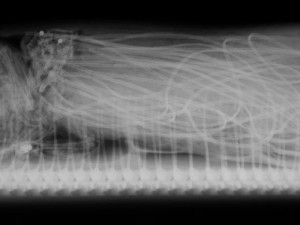The law of the excluded middle is the constant demand imposed upon statements to be true or false, it is both the exclusion of abandoned facts and the affirmation of everything leading up to the demand. The poor thing is often outside of the finite conclusion- made by whatever reason, in whatever fashion; as a result of verificationism and the desire for meaning. Things that exist outside of the definition of the thing, the informe, as Krauss put it, put to one side in favour of an ancient simplified polemic.
Artists are in a constant state of availability, ready for a talk, to verify their intentions, or to confirm and allay the doubts of the audience who have claimed the artist’s ideas before the work was even made. Imagine the luxury of being an artist who can say nothing, who is not present; which is, hypothetically, what apparently exists in theory, where culture claims these things and the artist is left regretting having thought for that split second- or for having the temerity to trust in the idea. Usually it is a social pre-requisite to trust the idea- manifest in the expression “artistic integrity”, which is another social aberration that is claimed by the audience/ outside world.
The size of the middle in this context is obviously vast and impenetrable, although the latter rests upon the finiteness of language understood by individuals. Intuitively, though, the middle is both epistemological and humungous; it is the part representation of something inconceivable and overwhelming in comparison to ourselves- and people’s perception of the truth lies within that. The dichotomy is the easy bit; is the finite ontic phenomena and in this instance a utility for determining- and demanding- some kind of result or, rather, a utility that is analogous to a situation of demands that are ultimately our responsibility in accepting or rejecting. There is so much time at the extreme end of things and monolithic texts, continents, oceans, the atmosphere, physically and socially inhumane living conditions, vacuums, pressure, the literal length of time that exists, history; they all serve as a deterrent for thinking in the middle. It’s intimidating.
What seems evident is our willingness to try and attempt some kind of ontological epistemology, to become luminous beings and to, either in rationalism or intuition, submit as much of ourselves to the question and absorb as much of the question into ourselves. Defining the point where/ when this occurs seems a trivial thing in comparison to the potential- or suspected bulk- of the phenomena and the nobility and braveness required for people to participate in this difficult and ambiguous situation. That vastness is linked to knowing- or gnosis- a person suspects what things are- or may be and it is intuited but there always exists the doubt of being unable to prove or realistically comprehend as to what its actual size or value is and lots of other things we relentlessly ask. Asking questions is difficult; getting answers is rewarding but in a [perverse] temporal/ suspended way. The pessimist in me would say I have received no answers when actually I answered questions that have led to this statement, I suppose awareness, in this case, is a reflection of the person, whether they are grateful for what they have or not.
The emotional side of truth is difficult to reconcile socially, where one person’s burden is another person’s gain and art as an empathetic environment to the trials and tribulations of humanity. Personally, there is still a desire to fuck things up. In the middle there exists great swathes of judgmental and conceited behavior, the attributes of people being passed on to this ridiculous anthropomorphic form of art we invent when we discuss something phenomenologically. It is the guise of positivity as a form for change, which prevails in social behavior and art but where cynicism and negativity and skepticism, which are all essential and vital forms of scientific analysis, are abandoned, or discouraged- considered inappropriate. Science has an advantage over art in that it call really recreate the most destructive force of negativity for its means, placing responsibility of its users. The Internet moderates itself morally, outside of the realm of its designers and moderators, by the way it discourages certain aberrant social behavior- the troll, or the way a person leaves Youtube comments alone, who should know better, where a retarded sub culture exists (I’m not going to say youth). The Facebook page and the Twit feed and before that, writing itself, are all forms of socially moderated behaviour and it is easy to look for either personal conceits or the wider sociological conceits- or, specifically, conceits endemic to artistic practice. The professional versus the wannabee versus the nobody versus the anarchist versus the nice person versus the idiot versus the tourist versus the sycophant versus the genius versus the talented- ad infinitum. The judging continues.
How do you define responsibility as an artist who doesn’t own their ideas? Who is not needed to be present? Firstly it is a statistic miracle that a human can exist, secondly it is a miracle that a human can be happy when they look at certain aspects of the world objectively- and what happens to artists is a trickle down effect of a diminishment of being, where, if they were to be silent enough, an inversion would occur- like a social void or a black hole, where language and society is left with nothing to take and then starts to consume it self like ourobouros: the snake eating its tail. It is strange to think that this has occurred by talking, whether it pre-empts the scenario is a different matter.
Upside down x-ray of a snake that had swallowed a heating blanket
Tags: Cultural logics, Mass media
